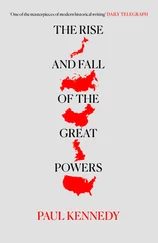“Anything’s possible, if you’re talking about the facing,” said the architect on the Bishop’s right. “What counts in a building, be it skyscraper or cathedral, is the steel. That’s all that holds it together.”
“Oh, it’s safe ,” said the contractor on the Bishop’s left. He must have seen that the Bishop could use a little reassurance on that point. “It’ll be good for fifty, seventy-five — maybe a hundred — years.”
The architect nodded.
Driving up to the job on his return from Rome (where, except for the Holy Father, nobody had seemed very glad to see him), the Bishop was pleased to note how much had been accomplished in his absence. But then, getting out of the car, coming closer and looking up at the arches, none of which had been completed when he last saw the cathedral, he couldn’t believe his eyes. Going inside, he found, of course, that what was true of one arch was true of all — those over the windows, those along the aisles, the one over the baptistery, and, worst of all, the one over the sanctuary. In the middle of every arch there were two stones— where the keystone should have been there was just a crack .
Had any of the responsible parties been with him then — Monsignor Gau, Frank or Frank, or any of the Becks — the Bishop wouldn’t have been able to conceal his dismay. He decided to say nothing. In the evening, he consulted the complete set of plans in Monsignor Gau’s office — and wished that he hadn’t relied so much on just the floor plans, for the plans he was looking at did show how the stone would be set. But they didn’t say why.
The next day, at the job, the Bishop approached a workman and said in an offhand manner, “No keystones in the arches.”
The workman said that keystones weren’t necessary in these arches — that steel was all that counted in a building nowadays. From another workman whom he questioned in the same manner the Bishop received much the same reply, and again did not pursue the matter. The following day, an intelligent-looking truck driver, the father of seven, told the Bishop that keystones in the arches would have clashed with the architects’ overall plan. The Bishop nodded, hoping to hear more, but did not. The next day, the Bishop spoke to one of the Becks about cathedral-building in the Middle Ages, saying in an offhand manner, “I suppose keystones in those arches would’ve clashed with the architects’ overall plan,” and was told that you didn’t see keystones much anymore. Then for two days the Bishop was out of town, but on his return he tried one of the architects, saying, “You don’t see keystones much anymore.” You did, he was told. You still saw them, and more often than not, if not always, they were ornamental. Out of honesty to their materials and, in the case of the new cathedral, out of a desire to give a light and airy feeling to what was, after all, a very heavy structure, Frank and Frank had rejected keystones. It hadn’t been easy to give what was, after all, a very heavy, horizontal structure, and a rather low one at that, a vertical feeling. That was what the cracks did, and what keystones, apart from being obsolete, would not have done.
That was early in May — a very wet month, as it turned out. At the job, there were signs of erosion and subsidence, and the ground was quickly sodded. Fortunately, the hairline cracks that appeared here and there in the fabric of the structure, and that had to be expected, did not widen.
At the Chancery, there were also signs of erosion and subsidence in the Bishop’s relations with Monsignor Gau, but here the hairline cracks (which, perhaps, had been present before) did widen. The work of the diocese went on, of course, but there was much less dining out than there had been. The Bishop didn’t enjoy being with Father Rapp, and Muldoon and the others, who seemed to appear regularly at the Webb at Monsignor Gau’s invitation, and who, though they gave the Bishop all the attention he could stand, still had a way of excluding him from the conversation. On confirmation trips, more often than not, the Bishop was driven by a curate — the Bishop had given Monsignor Gau a third one for Christmas. Much as Monsignor Gau enjoyed being with the Bishop, driving him and attending him, he could seldom manage it that spring. “Chancellor” was no longer a synonym for “chauffeur” in the Ostergothenburg diocese. Monsignor Gau was chancellor in the proper sense of the word, as well as rector of the Cathedral, building inspector for the diocese at the job, and troubleshooter there and everywhere — no man in the diocese below the rank of bishop had ever been so honored, trusted, and burdened with responsibility. Monsignor Gau also ran the newly created Diocesan Procurement Office.
The D.P.O. stocked, or took orders for, practically everything a Catholic institution required — school and office supplies, sporting goods, playground equipment, sacramental wines. It was saving money for the priests, nuns, and people of the diocese, but it also made demands on Monsignor Gau’s time and energy. He had to spend long hours with his catalogues and clipboard in the basement of the high school, and he had to go out of town on buying trips. There had been one or two too many of these, it seemed to the Bishop, who hadn’t anticipated any when he authorized the D.P.O., which, though, was unquestionably a success.
However, when the Bishop had approved the sale of sweatshirts bearing his coat of arms to seminarians and clergy, he hadn’t anticipated seeing one of these articles, as he did in the middle of June, in front of Hokey’s department store, on the person of a well-developed young lady. Immediately, he stepped into the lobby of the Webb, phoned Monsignor Gau, and asked that the stock of sweatshirts be checked. “No more, when those are gone,” he said, after he’d got the count.
“Gee,” said Monsignor Gau, but he sought no explanation, and the Bishop offered none.
By June, that was how it was with them. During the previous winter, at Monsignor Gau’s suggestion, the Bishop had become a columnist in the diocesan paper, dealing with events at home and abroad, and more than holding his own, according to Monsignor Gau, Father Rapp, and others. In June, he gave up his column. “No more,” he said, again in a way that didn’t invite questions. That wasn’t all. For over a year, at Monsignor Gau’s suggestion, letters of congratulation had been going out to Catholics in the diocese who had done something worthy of the Bishop’s attention — an honor defined with great latitude by Monsignor Gau — and then, in June, the Bishop ended the practice. “No more,” he said.
The Bishop was sorry that he couldn’t think of better ways to assert himself in his relations with Monsignor Gau, and was quite prepared for the consequences. Total obscurity held no fears for him at the moment — not that that would ever be his fate. He just didn’t want it thought that he wasn’t running the diocese. Or was it already too late — again — for any but the strongest proof? If it was, did he wish to give such proof — again? Monsignor Gau was a very popular man with the people, as well as a very successful one. Monsignor Holstein hadn’t been either. And the Bishop was older now.
The Bishop had never felt so out of it as he did late in July, at the dedication of the new cathedral. For many months, Monsignor Gau had been busy with the arrangements — not only bishops from nearby sees were asked to attend but also several archbishops, whose acquaintance, it seemed, Monsignor Gau had made, or almost made, on his buying trips. Two archbishops actually showed up for the dedication, as did an unimportant and indigent Italian cardinal, an added starter, who had more or less invited himself. This, apart from the expense of flying the man in, round trip and first class, from Syracuse (N.Y.), where he had relatives, was unfortunate. He talked a lot of nonsense about rice, having been informed somewhere that this was a major crop in Minnesota, as it was in his part of Italy, and nobody had the nerve to tell him that the only rice in Minnesota grew wild and was harvested by a few Indians.
Читать дальше












